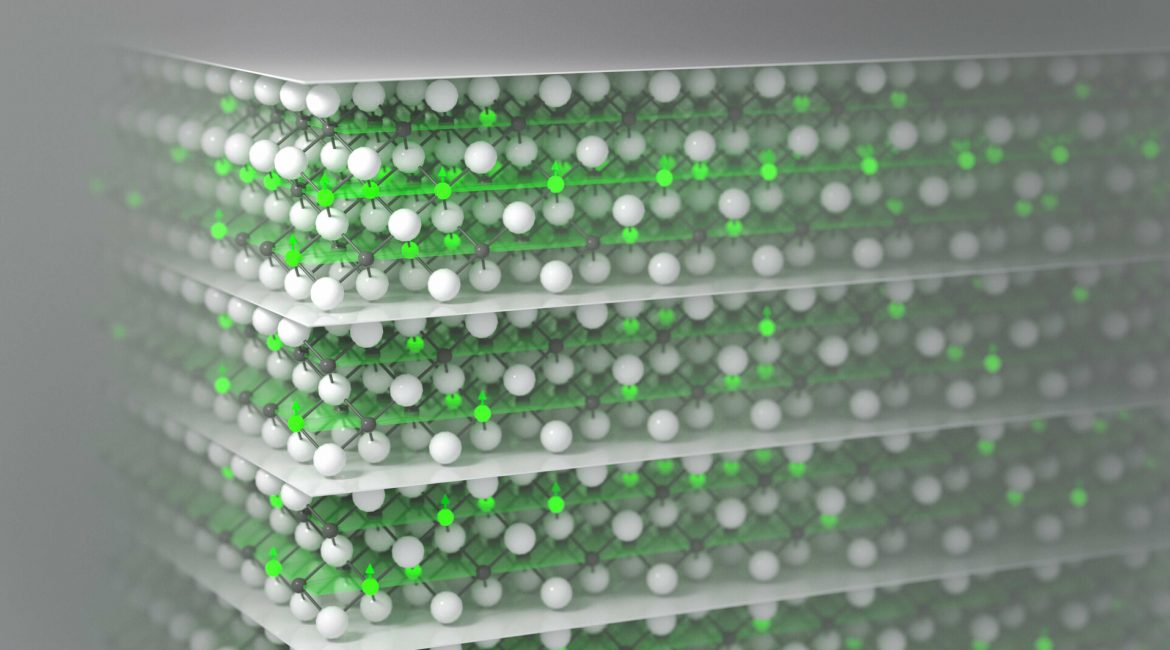| Mar 21, 2023 |
|
(Nanowerk News) Magnetic topological insulators are an exotic class of materials that conduct electrons without any resistance at all and so are regarded as a promising breakthrough in materials science. In 2019, an international research team headed by materials chemist Anna Isaeva, at that time a junior professor at ct.qmat (Complexity and Topology in Quantum Matter), caused a stir by fabricating the world’s first antiferromagnetic topological insulator – manganese bismuth telluride (MnBi2Te4).
|
|
This remarkable material has its own internal magnetic field, paving the way for new kinds of electronic components that can store information magnetically and transport it on the surface without any resistance. This could revolutionize computers by making them more sustainable and energy-efficient. Since then, researchers around the globe have been actively studying various aspects of this promising quantum material, eager to unlock its full potential.
|
Milestone achieved with MnBi6Te10
|
|
Based on the previously discovered MnBi2Te4, a team from ct.qmat has now engineered a topological insulator with ferromagnetic properties known as MnBi6Te10.
|
|
The findings have been published in the journal Advanced Science(“Intermixing-Driven Surface and Bulk Ferromagnetism in the Quantum Anomalous Hall Candidate MnBi6Te10“).
|
 |
| A team of researchers from the Cluster of Excellence ct.qmat based at the universities JMU Würzburg and TU Dresden has engineered the topological insulator manganese bismuth telluride (MnBi6Te10) to make it ferromagnetic. The amazing thing about this quantum material is that its ferromagnetic properties only occur when antisite disorder is introduced into its atomic structure. To achieve this, some manganese atoms (green) need to be relocated from their original position (second green atomic layer from the top). Only when manganese atoms are present in all the layers containing bismuth atoms (gray) does the magnetic interaction between them become sufficiently contagious to point them in the same direction and create ferromagnetism. (Image: Jörg Bandmann/ct.qmat)
|
|
In ferromagnetic materials, the individual manganese atoms are magnetically aligned in parallel, meaning that all their magnetic moments point in the same direction. By contrast, in its antiferromagnetic predecessor, MnBi2Te4, only the magnetic moments within a single layer of the material are aligned in this way.
|
|
The slight change in the crystal’s chemical composition has a major impact, as the ferromagnetic topological insulator MnBi6Te10 exhibits a stronger and more robust magnetic field than its antiferromagnetic predecessor. “We managed to fabricate the quantum material MnBi6Te10 such that it becomes ferromagnetic at 12 Kelvin.
|
|
Although this temperature of –261 degrees Celsius is still far too low for computer components, this is the first step on the long journey of development,” explains Professor Vladimir Hinkov from Würzburg. It was his group who discovered that the material’s surface exhibits ferromagnetic properties, enabling it to conduct current without any loss, whereas its interior doesn’t share this characteristic.
|
Race for the miracle material
|
|
The ct.qmat research team wasn’t alone in aiming to create a ferromagnetic topological insulator in the laboratory. “Following the remarkable success of MnBi2Te4, researchers worldwide began searching for more candidates for magnetic topological insulators. In 2019, four different groups synthesized MnBi6Te10, but it was only in our lab that this extraordinary material displayed ferromagnetic properties,” explains Isaeva, now a professor of experimental physics at the University of Amsterdam.
|
Antisite disorder in the atomic structure
|
|
When the Dresden-based materials chemists led by Isaeva painstakingly figured out how to produce the crystalline material in a process akin to detective work, they made an astonishing discovery. It turned out that some atoms needed to be repositioned from their original atomic layer, meaning they had to leave their native arrangement in the crystal.
|
|
“The distribution of manganese atoms across all crystal layers causes the surrounding manganese atoms to rotate their magnetic moment in the same direction. The magnetic order becomes contagious,” explains Isaeva.
|
|
“Atomic antisite disorder, the phenomenon seen in our crystal, is usually considered disruptive in chemistry and physics. Ordered atomic structures are easier to calculate and better understood – yet they don’t always yield the desired result,” adds Hinkov.
|
|
“This very disorder is the critical mechanism that enables MnBi6Te10 to become ferromagnetic,” emphasizes Isaeva.
|
Collaborative network for cutting-edge research
|
|
ct.qmat scientists from the two universities TU Dresden and JMU Würzburg as well as from the Leibniz-Institut für Festkörper- und Werkstoffforschung (IFW) in Dresden collaborated on this groundbreaking research. The crystals were prepared by a team of materials chemists headed by Isaeva (TU Dresden). Subsequently, the samples’ bulk ferromagnetism was detected at IFW, where Dr. Jorge I. Facio also developed a comprehensive theory explaining both the ferromagnetism of MnBi6Te10 characterized by antisite disorder and its antiferromagnetic counterparts. Hinkov’s team at JMU Würzburg conducted the vital surface measurements.
|
|
The researchers are currently working to achieve ferromagnetism at considerably higher temperatures. They’ve already made initial progress, reaching around 70 Kelvin. Simultaneously, the ultra-low temperatures at which the exotic quantum effects manifest need to be increased, as lossless current conduction only starts at 1 to 2 Kelvin.
|


